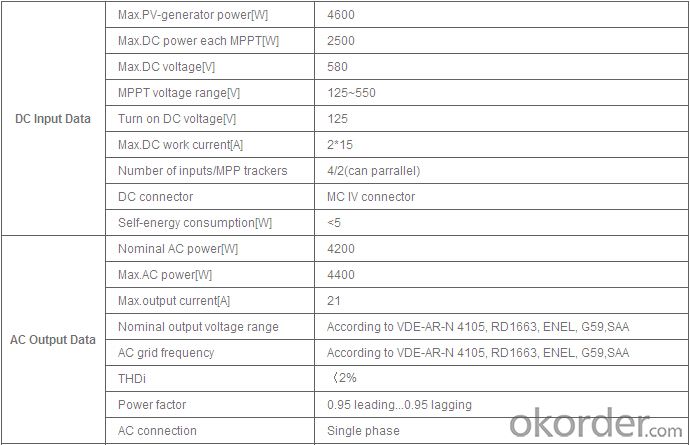On grid solar inverter GW4200-DS
OKorder Service Pledge
OKorder Financial Service
You Might Also Like
GW4200-DS
GW4200-DS photovoltaic inverter is suitable for home rooftop photovoltaic system, designed under modern industrial concept.
There are three colors for option with fashionable appearance.
This model uses advanced digital control technology and communication method as well as super MPP tracking and security technology.
It has a wide range of input and output voltage.
To ensure its stability and long service life, our inverter is manufactured with optimum quality components.
It holds a safe lead among the same level of products.
Datasheet

- Q:What is the maximum power capacity of a solar inverter?
- The maximum power capacity of a solar inverter can vary depending on the specific model and brand. However, in general, solar inverters can have power capacities ranging from a few hundred watts to several kilowatts, with some larger industrial-grade inverters capable of handling even higher power capacities.
- Q:What is the purpose of a solar inverter?
- The purpose of a solar inverter is to convert the direct current (DC) electricity generated by solar panels into alternating current (AC) electricity that can be used to power household appliances and be fed back into the electrical grid.
- Q:Can a solar inverter be used in systems with multiple inverters?
- Yes, a solar inverter can be used in systems with multiple inverters. In fact, in large-scale solar installations, multiple inverters are often used to handle the increased power output. These inverters are connected in parallel or series to ensure efficient and reliable operation of the entire system.
- Q:What is the efficiency loss of a solar inverter over time?
- The efficiency loss of a solar inverter over time can vary depending on various factors such as the quality of the inverter, maintenance practices, and environmental conditions. Generally, solar inverters experience a gradual decrease in efficiency over their lifespan. On average, the efficiency loss can range from 0.5% to 1% per year. However, regular maintenance and monitoring can help minimize this loss and ensure optimal performance.
- Q:What are the different power output modes of a solar inverter?
- The different power output modes of a solar inverter include grid-tied mode, off-grid mode, and hybrid mode. In grid-tied mode, the solar inverter synchronizes with the utility grid, allowing excess solar energy to be fed back into the grid. In off-grid mode, the inverter operates independently, powering electrical loads directly from solar energy and often utilizing batteries for energy storage. Hybrid mode combines both grid-tied and off-grid functionality, allowing the inverter to switch between grid-connected and standalone operation as needed.
- Q:What is the role of a transformer in a solar inverter?
- The role of a transformer in a solar inverter is to convert the direct current (DC) electricity generated by the solar panels into alternating current (AC) electricity suitable for use in homes and businesses. The transformer helps to step up or step down the voltage levels, ensuring efficient and safe transmission of electricity from the solar panels to the electrical grid or connected loads.
- Q:How does a solar inverter handle harmonic distortion?
- A solar inverter handles harmonic distortion by incorporating various filtering and control mechanisms. These mechanisms help to minimize and mitigate the impact of harmonic distortion caused by the non-linear loads associated with solar panels. The inverter typically employs filters and algorithms that actively monitor and adjust the output waveform to reduce harmonics. This ensures that the generated electricity is of high quality and meets the required standards for grid connection.
- Q:What is the maximum short-circuit current that a solar inverter can handle?
- The maximum short-circuit current that a solar inverter can handle varies depending on the specific model and design. However, most solar inverters are designed to handle short-circuit currents ranging from 500 Amps to 10,000 Amps, depending on the size and capacity of the inverter.
- Q:What are the potential risks of fire or explosions from a faulty solar inverter?
- The potential risks of fire or explosions from a faulty solar inverter include electrical malfunctions, overheating, short circuits, and insulation failures. These issues can lead to the accumulation of heat and energy, causing fires or explosions. Additionally, if the faulty inverter fails to properly regulate the flow of electricity, it can damage connected electrical devices or even cause electrocution hazards. Regular maintenance and inspections are crucial to minimize these risks and ensure safe operation of solar inverters.
- Q:Can a solar inverter be used with batteries for energy storage?
- Yes, a solar inverter can be used with batteries for energy storage. The solar inverter converts the DC (direct current) electricity generated by the solar panels into AC (alternating current) electricity that can be used to power household appliances. When connected to batteries, the excess solar energy generated during the day can be stored in the batteries for later use, such as during nighttime or when the solar panels are not producing enough electricity. This allows for a more efficient and reliable use of solar energy.
1. Manufacturer Overview |
|
|---|---|
| Location | |
| Year Established | |
| Annual Output Value | |
| Main Markets | |
| Company Certifications | |
2. Manufacturer Certificates |
|
|---|---|
| a) Certification Name | |
| Range | |
| Reference | |
| Validity Period | |
3. Manufacturer Capability |
|
|---|---|
| a)Trade Capacity | |
| Nearest Port | |
| Export Percentage | |
| No.of Employees in Trade Department | |
| Language Spoken: | |
| b)Factory Information | |
| Factory Size: | |
| No. of Production Lines | |
| Contract Manufacturing | |
| Product Price Range | |
Send your message to us
On grid solar inverter GW4200-DS
OKorder Service Pledge
OKorder Financial Service
Similar products
New products
Hot products
Hot Searches
Related keywords






























